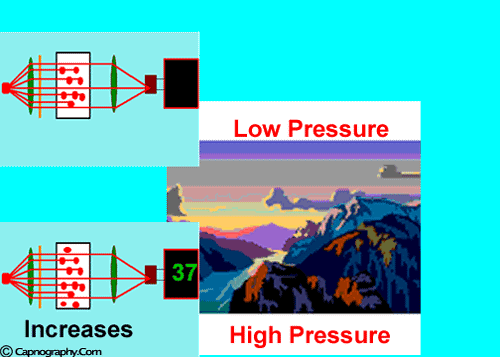Physics of capnography
Factors affecting IR Spectrography

How does atmospheric pressure affect CO2?
The effect of Atmospheric pressure can be minimized by:-
Measuring CO2 as partial pressures
Calibrating with a known concentration of CO2 as partial pressure at the site of measurement
Keeping the sampling flow rate into the capnometer constant
Changes in atmospheric pressure do not affect the C02 concentration (FC02) but rather what is interpreted by the detector as C02. A change in atmospheric pressure directly influences the reading of capnometers since C02 concentration is measured as partial pressure (direct effect). Further, an indirect effect is seen when a capnometer reports measurements in volume percent instead of partial pressure.1
Direct Effect:
This has two mechanisms.
(a) An increase in pressure proportionately increases the number of IR absorbing C02 molecules and thereby increases the C02 signal. A 1% increase in pressure causes a 1% relative increase in the C02 signal. This effect is eliminated by calibrating the capnometer with a known partial pressure of the C02 gas (mmHg = vol% * atmospheric pressure) using a commercially available calibrating gas. Given such a calibration, the capnometer will display CO2 concentrations within its measurement cuvette as partial pressure, regardless of changes in the atmospheric pressure.1 However, if the capnometer is calibrated in volume percent, then FC02 readings will need to be corrected for changes in atmospheric pressure (a 1% increase in pressure produces a 1% relative increase in FC02 value).2
(b) Changes in pressure also produce a second effect (alteration of intermolecular forces) exerted by C02 molecules, which alters the IR absorption. An increase in pressure by 1% results in a relative increase in the signal by 0.5 to 0.8% which can produce a small error.2,3
Maximal changes in the atmospheric pressure caused by changes in the weather are of the order of 20 mmHg. This would result in a change in PC02 of less than 0.5 to 0.8 mmHg (measurement range of PC02, 30-40 mmHg). Therefore, in routine clinical use, corrections for changes in atmospheric pressure are unnecessary.2 However, in studies in which precision is needed corrections for variations in barometric pressure are useful. Increases in the sampling flow rate of side-stream C02 sensors result in a reduction of pressure at the airway and lower apparent C02 measurements. However, if the unit is calibrated at the average prevailing atmospheric pressure and sampling flow does not change, the unit should be sufficiently accurate for clinical measurements. Further, application of PEEP (positive end expiratory pressure) increases the C02 reading. A PEEP of 20 cm H20 increases the C02 reading by 1.5 mmHg.1 Some units measure the pressure in their sensor and automatically adjust the C02 reading accordingly.1,3,4
INDIRECT EFFECT
The indirect effect of atmospheric pressure on the PCO2 values results when an analyzer reports measurements in volume percent. In conjunction with measurements of arterial blood gas tensions, it is preferable to record the readings as PCO2(mmHg) and not as volume percent. The atmospheric pressure at the time of measurement must be known to compute a PC02 value (mmHg = FC02 * atmospheric pressure).1 However, if the atmospheric pressure at the time of measurement differs from the atmospheric pressure at the time of calibration, then the observed FC02 readings should be corrected for the two components of “direct effect” of atmospheric pressure changes before computing the PC02 value.2,3
The effect of high altitude on the capnographs:
Pattinson, et al studied the the effect of high altitude on capnographs.5 They determined that pressure decreases at higher altitudes produced altered reading that may be unrelated to calibration of the instrument. The authors used Datex-S/5 portable critical care monitor, K4b2 (Cosmed), Datex Cardiocap, and Ohmeda 4700 in their study. Each instrument was assessed in the decompression chamber to simulated altitudes of 3600 m, 4800 m, and 5260 m. Despite calibration of these instruments according to the manufacturer’s instructions, Datex-S/5 and Ohemda 4700 showed increased percentage CO2 readings as altitude increased. The Datex Cardiocap did not give any readings following decompression to 3600 m. The K4b2 readings increased slightly at higher altitudes but the results remained close to the 5% expected from the test gas. However, there was an error of nearly 7% in the CO2 reading at sea level.
The authors give following explanation for the observed altered readings:
1. Reduced gas flow rates through the sampling chamber due to increased difficulty encountered by the pump as a result of decreased density of the gases at lower pressures.
2. The second explanation for malfunction of the instrument is the effect of low barometric pressure on calibration. This influences the gas flow rate and the infra red spectroscopy measurements. These effects on the measurements can be corrected by re-calibration at the ambient pressures.
3. The third explanation is the effect of reduced barometric pressure on computer software within the instruments. Capnographs have an in-built barometer from which computer algorithms are used to compensate for changes in barometric pressures. According to the authors,5 Datex-Ohmeda have informed them that their machines have minimal barometric pressure limit, below which they become unreliable because the instruments assume the barometric pressure to be at that level and give incorrect values acccordingly.
Capnographs such as Datex-Ohemeda specifically excludes the use of their instruments at barometric pressures below 66.5 kPa.
References:
1. Raemer DB, Calalang I. Accuracy of end-tidal carbon dioxide tension analyzers. J Clin Monit 1991;7:195-208.
2.Olsson SG, Fletcher R, Jonson B, Nordstrom L, Prakash O. Clinical studies of a gas exchange during ventilatory support – a method of using the Siemens-Elema CO2 analyzers. Br J Anaesth 1980;52:491-9.
3.Paloheimo M, Valli M, Ahjopalo H. A guide to CO2 monitoring. Finland: Datex Instrumentarium, 1988.
4. Carbon dioxide Monitors. Health Devices 1986;15:255-85.
5. Pattinson K, Myers S, Gardiner-Thorpe C. Problems with capnography at high altitude. Anesthesia 2004;59:69-72.

 Twitter
Twitter Youtube
Youtube









